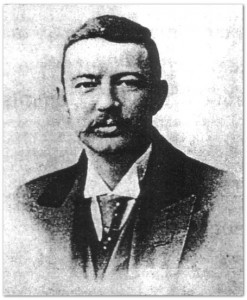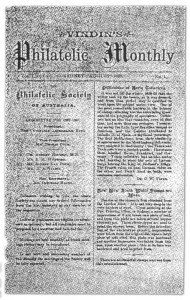Dawson Vindin is notable for being Australia’s first successful philatelic publisher and Sydney’s leading stamp dealer during the 1880s and early 1890s. His magazine, Vindin’s Stamp Monthly, commenced in 1887 and was the first of its kind to survive in Australia. For the past 111 years, a monthly magazine has been a regular feature of the Australian stamp scene.
Dawson A. Vindin was probably born in Sydney in 1868. He obviously developed an interest in stamps during childhood because at the tender age of 12 he joined the business of Edward Buckley, a stamp dealer of 7 Little George Street, Sydney. Buckley was possibly Australia’s first stamp dealer, as it is recorded that he was in business during the 1860s. In November 1879, Buckley published the New South Wales Stamp Collectors’ Magazine and this was followed by two more issues over the next 18 months. Coincidentally, Fred Stanley of Adelaide published the Australian Stamp Collectors’ Journal in November 1879 (it lasted only four months), so it is not possible to say conclusively which is the first philatelic magazine in Australia.
In March 1882, Dawson Vindin took over Buckley’s business, which he moved to 88 Elizabeth Street, Sydney. Now aged 13 or 14, Vidin had become Sydney’s principal stamp dealer. Not only that, but he also took on publishing a magazine. A new series of the New South Wales Stamp Collectors’ Magazine was launched in August 1882, but only one edition appeared. Vindin’s second effort was the New South Wales Philatelist. It was twice as successful, there being two numbers – November 1882 and January 1883. Both magazines depended greatly on articles culled from overseas journals.
All these journals, the first and second series of the New South Wales Stamp Collectors’ Magazine and the New South Wales Philatelist, are very rare. Complete files of each are in the Crawford collection in The British Library and a nearly complete holding is in the Royal Philatelic Society of Victoria library. There is also an incomplete set in the Philas library and odd numbers are in other libraries and private collections.
Dawson Vindin made his third attempt with Vindin’s Philatelic Monthly, which made its first appearance in August 1887. This was propitious timing, since the Philatelic Society of Australia was established in Sydney two months earlier by a new generation of stamp collectors that had arisen. Vindin was a committee member of the new Society, which although very shortlived, was influential in initiating the NSW Centennial stamp series – the first commemorative stamps to be issued by a government postal administration. Vindin confidently predicted that his new magazine “…will appear promptly for the next twelve months and that those wishing to do so can safely send in their subscriptions.” The selling price was 2d per copy and the first ten numbers appeared regularly up to May 1888. That of January 1888 was a “Centennial” number and Dr. Andrew Houison contributed an article on NSW stamps which resulted in a double-size (16 pages) issues.
Vindin’s Philatelic Monthly was first regularly
published philatelic journal in Australia.
The first issue appeared in August 1887.
A short piece in the September 1887 issue of the magazine comments that “88 Elizabeth-street is now the recognised “Exchange” and meeting place of the Sydney collectors, and each afternoon, after four, may be seen the familiar faces of Messrs. Pugh, Van Dyck, Hagen, Dr. Houison and other leading collectors, meeting together “in congress” to discuss the latest “finds and discoveries.” In early 1888, Vindin closed his city shop and operated from his private home, Philatelia, at 15 Cascade Street, Paddington. He reopened a shop at no. 9-11 Victoria Arcade, Sydney, in late 1889. This remained Vindin’s premises until he relocated to London four years later.
Vindin’s Philatelic Monthly reported the sale of 1,900 Excelsior packs by Vindin’s firm during August 1887, comprising over 100,000 stamps – a surprising figure given what one would imagine to be a small market at that time. These packets ranged in price from 3d to 5/- and were made up with various selections of Australasian and overseas stamps. For each purchase of 2/6d, Vindin allocated a numbered ticket in a monthly raffle, which offered prizes of cash and other stamp selections. Vindin offered an unequivocal guarantee that all the stamps he sold were genuine or if otherwise, a refund would be made. He claimed to be “…the only firm in Australasia prepared to give and carry out this guarantee.” Vindin ran a regular column in his magazine, “A Polite Request”, which listed the names of those customers who should write to his firm “…as it is unpleasant to be constantly writing to them without avail.”
Vindin’s Philatelic Monthly did not appear between May and December 1888, apparently because Dawson Vindin pursued other (unsuccessful) business interests. What these interests were was not disclosed in a statement in December 1888 which promised to restore the magazine’s regularity and devote full attention to his stamp business. Nevertheless, there were problems with the magazine as during 1889 and the first half of 1890 the size of each issue halved to four pages, two of which were advertising. There was very little local editorial – most of this was culled from overseas journals, in particular Philatelic Monthly, published by an American dealer, L. Durbin, who visited Australia in 1888.
The bad days, however, were past by August 1890 when an “improved series” of Vindin’s Philatelic Monthly began with 16 pages in each issue, on good quality paper and with a coloured cover. There was much more information on local philatelic happenings and more original articles. The real change came with the absorption of the Federal Australian Philatelist in October 1891. This quarterly journal had been edited by A.F. Basset Hull in Hobart, but had to cease publication as the specialist nature of its articles did not find wide enough appeal. Dawson Vindin took on Basset Hull to act as editor of Vindin’s Philatelic Monthly and from this time the magazine was further improved. Vindin was relieved of the pressure of finding copy for each issue and from his dependence on reprinting material from overseas journals. Hull relocated to Sydney to work on the magazine.
There were new recruits to Vindin’s Philatelic Monthly – David Hill wrote on the stamps of Victoria, as did A.J. Derrick. The establishment of the Philatelic Society of Victoria in 1892 encouraged the growth and research activities of the Melbourne philatelic scene. Another contributor of note was E.D.E. Van Weenen, who used the nom-de-plume, Timbrologist. Hull himself wrote an important serial on the stamps of Queensland.
While the journal itself was stronger than ever, Dawson Vindin himself had his troubles. In Stanley Gibbons Monthly Journal of September 1891 the scandal of the NSW Laureate reprints was exposed, in which Vindin was now implicated. He had offered sheets of the 2d, 6d and 8d Laureates in 1887 for £200 a set to various English philatelists. It now transpired, however, that these were in fact reprints made from the original printing plates by a Sydney collector, Anthony Van Dyck. In 1891, it became clear that the few sheets offered by Vindin were not the only ones in existence and their identity as reprints was confirmed. Vindin protested his innocence, claiming he had been taken in by Van Dyck like everyone else. Vindin explained that in about 1884 he purchased unused Laureate stamps from an anonymous customer who he believed to be a government official. Three years later, Van Dyck met this person through Vindin and shortly afterwards Van Dyck obtained the Laureate printing plates, although he did not disclose this to Vindin. Van Dyck supplied sheets of Laureates to Vindin for resale, but kept a plentiful supply himself for sale.
In December 1891 Dawson Vindin left Sydney by ship “to investigate the London aspect of the now celebrated Laureated New South Wales business”. While on board ship and in England and Europe, he wrote of his travel experiences for Vindin’s Philatelic Monthly. These include the hour taken to register three letters with a “wily Cingalese” at the GPO in Colombo; visiting the Stanley Gibbons’ shop in the Strand where he saw “…close on £300 taken in cash over the counter within an hour”; attending the Old Bailey trial of the “celebrated gang of stamp forgers – Benjamin, Sarpy and Jefferies” (the latter named his home Sydney Views Villa in honour of his forgeries); and attending a rare, private viewing of Phillipe Von Ferrary’s collection, during which the curator told Vindin that Von Ferrary would find it “distasteful” if notes were taken of the collection’s rarities.
During Vindin’s absence, his business in Sydney was carried on by Fred Hagen, who had joined the firm as a partner in 1891 (see “Philatelic Profile” in Australasian Stamps, June 1998). Vindin returned in May 1892, but he obviously found London beckoning, because he left again in October 1893 with the intention of establishing a business there. He sold his Sydney business to Hagen. On the voyage to Europe, one of Vindin’s fellow passengers was the Earl of Kintore, Governor of South Australia, who was “quite well informed on philatelic matters.” Lord Kintore had collected in earlier years and once bought a Penny Black “VR” for three pounds.
Vindin’s departure from the Sydney scene meant the end of Vindin’s Philatelic Monthly, at least in name. It continued for a short time while Hagen traded as D.A. Vindin & Co., but when he began trading under his own name the journal naturally had to change. In August 1894, Hagen launched The Australian Philatelist, which in essence was the same as its predecessor. The Australian Philatelist continued in publication until 1924, so it and Vindin’s Philatelic Monthly enjoyed a life of 37 years – a record in Australia which remained until after the Second World War.
Having established himself in London, Vindin commenced a new publication Vindin’s Stamp Trade Journal, which was almost purely a vehicle for advertisements and contained little editorial. The journal lasted only four issues during 1894. Vindin commented ruefully in the final issue that “we have come to the conclusion that the publishing of a philatelic paper is about the poorest business undertaking a man could possibly enter upon.”
A mystery now arises concerning Dawson Vindin. He is not referred to in the philatelic press again. In 1894, Vindin was still a comparatively young man of 26 and had achieved a good deal during his philatelic career. He presumably dropped out of stamp dealing and he must have lost all interest in philately for his name to be so completely ignored. It is unlikely that he died around this time, since this would have been noted in many publications. Vindin must have found other means of living that took him far way from stamps. As a result, it is not known where and when he died. If he had survived into his eighties he would have been alive in 1950s and might have been able to relate to some collectors stories about the very beginnings of philately in Australia.
Published by kind permission of the author.









Leave A Comment
You must be logged in to post a comment.